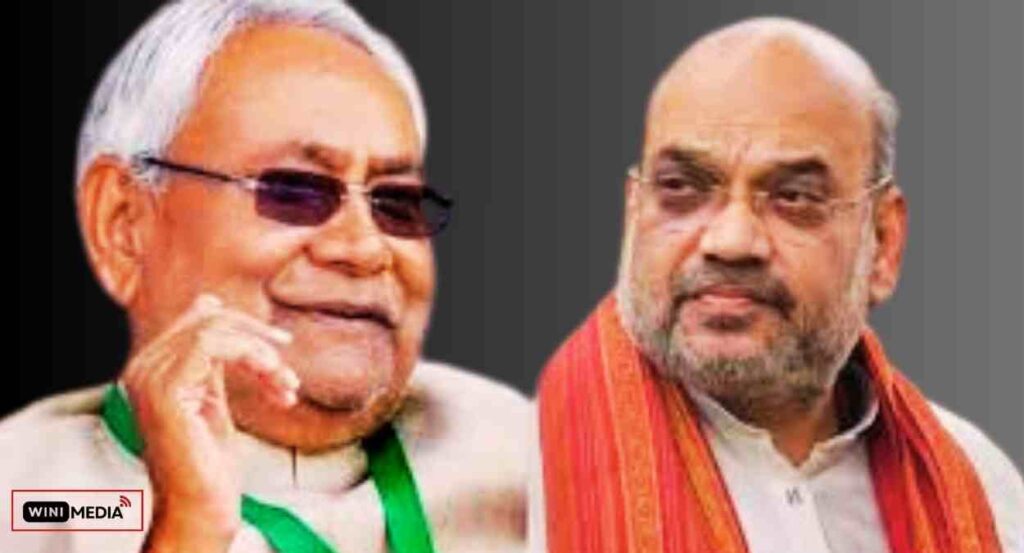{ Nitish Kumar, Bihar Politics, Political Alliances, Alliance Changes, Political Timeline,Political Maneuvers, Bihar’s Political Landscape, Ally Switches, Political Chessboard, Nitish Kumar’s History, Alliance Saga, Changing Alliances, Political Rollercoaster, Bihar’s Political Puzzle }

Bihar’s Political Rollercoaster: Nitish Kumar’s Alliances Through the Years!
Nitish Kumar: A Political Chameleon
Nitish Kumar is the current Chief Minister of Bihar. He has been in the news recently because he decided to leave the Rashtriya Janata Dal (RJD) and join the Bharatiya Janata Party (BJP) to form a new government in Bihar. Nitish Kumar is known for changing his political allies frequently to remain in power.
Nitish Kumar’s Political Career
Nitish Kumar’s political career began in the 1970s with the Janata Party. In the 1990s, he founded the Samata Party and joined the BJP-led National Democratic Alliance (NDA) government at the Centre. In 2003, his party merged into the Janata Dal (United), and Kumar became its leader.
Nitish Kumar’s Political Maneuvers
Nitish Kumar has been the Chief Minister of Bihar for a total of 16 years, making him the longest-serving Chief Minister of the state. Nitish Kumar is known for frequently changing his political allies to remain in power. He has switched between rival alliances led by the BJP and RJD over the years. As he eyes national ambitions in 2024, here is a timeline tracking his maneuvers to build caste coalitions and stay CM.

The Early Political Days
Nitish Kumar’s rise in politics began in the 1970s when he joined the Janata Party and later became an MP for the first time in 1989. In the early 90s, he served as a minister under Chief Minister Lalu Prasad Yadav’s government in Bihar.
However, the first signs of his maneuvering nature emerged in 1994 when Nitish exited Lalu’s Janata Dal party. Joining hands with George Fernandes, he formed the Samata Party in Bihar.
First Stint with BJP
In 1996, the ever strategic Nitish allied with the BJP to increase his political might in Bihar. This partnership with the BJP would continue for the next 17 years as he rose to become Chief Minister of Bihar twice during this period in 2000 and 2005.
Dumping BJP for his first ‘Mahagatbandhan’
However, Nitish surprised BJP in 2013 when tensions brewed over declaring Narendra Modi as BJP’s Prime Ministerial candidate. Refusing to accept Modi’s leadership, Nitish broke the 17-year-old BJP alliance.
In what became Indian politics’ first ‘Mahagatbandhan’ (grand alliance), Nitish joined hands with Lalu Prasad Yadav’s RJD and Congress – his once arch enemies.
Riding on this anti-BJP platform, Nitish won the 2014 general elections and continued as Bihar CM at the head of an unstable coalition.
Back to BJP in 2017 and CM Chair Retained
This realignment with Lalu and Congress was however short-lived. Incessant clashes and demands for his resignation by Lalu’s son Tejashwi Yadav culminated in Nitish again splitting and rejoining hands with BJP in 2017 to retain his CM seat.
2020 Polls and BJP Support
In the 2020 Bihar assembly elections, BJP won more seats than Nitish’s JDU. Yet, in another display of political gymnastics, Nitish managed to convince BJP to allow him to continue as CM – despite having lesser seats.
August 2022 Breakup – Return of Mahagatbandhan
In August 2022, Nitish has once again caused a political earthquake in Bihar – dumping BJP to reunite with his old rival Lalu Prasad Yadav and other regional parties to form government.
His critics slam such frequent political ‘U-Turns’ but Nitish wears the tag of an astute politician who keeps former friends and rivals guessing his next move.

Nitish Kumar’s Political Journey through the bullet points
Let us have a bird’s eye view again on his polytical journey with these bullets poins
1990s – Rise in Janata Dal
- Nitish Kumar started his political career with Janata Dal in the 1989 elections
- He gained prominence as a key strategist in Lalu Prasad Yadav’s government in 1990
- However, differences emerged and Nitish exited Janata Dal in 1994
1994 – Founded Samata Party
- Nitish Kumar founded his own party, the Samata Party with George Fernandes in 1994 after leaving Janata Dal
- The Samata Party allied with the BJP in the 1996 Bihar elections
- This BJP-Samata combine would last for 17 years
March 2000 – First Stint as CM, Backed by BJP
- In 2000, Nitish became CM of Bihar for the first time with BJP support
- But he resigned in 7 days as BJP withdrew support
Nov 2005 – Start of 15 Year BJP Alliance
- In 2005, JD(U) and BJP swept Bihar polls in an anti-Lalu wave
- Nitish became CM for the second term backed by BJP
- This NDA alliance governed for next 8 years
June 2013 – Broke 15 Year BJP Alliance
- As BJP declared Narendra Modi it’s PM candidate for 2014, Nitish exited the NDA
- His anti-Modi posturing was aimed at his Muslim-Yadav votebank
- JDU allied with RJD and Congress to form new coalition
Nov 2015 – Mahagathbandhan Wins
- The 2015 state polls saw a JD(U)-RJD-Congress Mahagathbandhan sweep into power
- Nitish won his 5th term as Bihar CM on an anti-BJP plank
- BJP was reduced to 53 seats out of 243
July 2017 – Shock Return to NDA
- In 2017, Nitish exited Mahagathbandhan citing corruption allegations on Lalu
- He resigned as CM only to realign with old ally BJP immediately
- The sudden reversal was likely aimed at countering Lalu’s heir Tejashwi
Nov 2020 – Stays CM Despite BJP Edge
- In the 2020 polls, BJP won 74 seats becoming the bigger NDA faction
- But JDU won just 43 seats yet Nitish was made CM under BJP “generosity”
- Nitish was possibly kept for his sway over Koeri-Kurmi votes
August 2022 – Back to Mahagathbandhan
- In August 2022, Nitish severed ties with BJP citing differences
- He realigned with RJD and Congress to form a new Mahagathbandhan government
- Nitish took oath as Bihar CM for the 8th time backed by RJD

Why Does Nitish Keep Switching Sides?
Nitish has exhibited stunning political maneuvering skills to retain power in Bihar for 20 years now. Here are the key reasons why he keeps changing allies:
Caste Calculations
- Nitish banks on his Kurmi caste votebank but needs allies to tap wider caste coalitions
- By alternating between BJP and RJD, he balances upper caste votes with Muslim/Yadav votes
Checkmate Rivals
- When Lalu’s RJD and BJP grow too strong, Nitish breaks alliance to cut them to size
- This prevents rivals from gaining enough seats to dislodge him
National Ambitions
- Nitish eyes an important national role by 2024 possibly as PM candidate for a United Opposition
- To make this bid, he needs to showcase power so can’t afford BJP gaining upper hand in Bihar
Stay Indispensable
- Nitish makes himself seem indispensable for partners to gain Bihar’s pivotal 40 Lok Sabha seats
- So despite much lower MLAs than BJP, he retains CM post
Development Over Ideology
Unlike traditional politicians, Nitish has chosen development and economic progress over political ideologies that typically dominate regional parties. This flexible and more inclusive development politics allows him to partner with BJP as well as so-called secular parties like Congress more easily.
Not too Dependent on Lalu
While Lalu Prasad Yadav’s MY (Muslim + Yadav) vote bank is big, Nitish has chosen to keep RJD at an arm’s length for better bargaining power. Being over-dependent on Lalu also exposes him to the taints of corruption and misgovernance that have plagued RJD’s past record.
Impact of Nitish’s Political Flip Flops on Bihar
While Nitish’s supporters praise his administrative track record, his political opportunism has also attracted its share of criticism:
- Frequent government collapses and reconstitutions have led to political instability in the state
- Key development works and economic decisions get stalled as a result hampering progress
- Allows corruption to institutionalize as terms get cut short before projects finish audits
- Weakens grassroot party organizations making them over-reliant on single leaders
- Significantly erodes voter confidence and trust in the democratic process
So while Nitish’s political antenna has helped him remain in the CM seat for 17 years now through changing state permutations, the long-standing impact of stunted governance also cannot be ignored.

Will BJP and Nitish Reunite Again Before 2024 Elections?
Some political analysts predict that Nitish and BJP may again come together before the 2024 Lok Sabha elections for mutual benefit:
- Nitish’s ties have soured with RJD over corruption charges
- Congress remains electorally weak compared to BJP
- Nitish wants to aim for one last stint at power before retiring
- Joining NDA again will give Nitish support from PM Modi’s popularity
However, with so much bad blood between them now, even a Nitish-BJP patch up cannot fully redeem voter trust. Nitish may need to make more principled and strategic choices about the future course of Bihar’s politics.
Final Takeaways from Nitish Kumar’s Political Journey
Looking back at Nitish Kumar’s five decades in politics as he turns 72, here are the key highlights:
- Nitish’s frequent political flip flops display the cunning tactician in him trying to maximise power
- Led to the rise of fractured coalition politics in Bihar with no dominant parties
- Negatively impacted governance delivery hurting people’s welfare
- Going forward Nitish needs to make more principled stands aligned to Bihar’s growth story beyond personal ambition
- 2024 elections will test if Nitish still wields credibility to shape Bihar’s future direction
In conclusion, while Nitish deserves credit for uplifting Bihar from its days of caste wars and poor law-and-order, his maverick political opportunism also diluted governance – making the state perennially politically fragile.
As a new generation of voters awake, it remains to be seen whether Nitish can redeem his legacy by making bold decisions or fade away as just another footnote in history. Only time will tell.

FAQs about Nitish Kumar’s history of changing political allies in Bihar:
Q1. Who was Nitish Kumar’s first political ally when he started his career?
A1. Nitish Kumar began his political career in 1989 with the Janata Dal party led by Lalu Prasad Yadav. He worked as an important strategist in Lalu’s government.
Q2. When and why did Nitish Kumar first break alliance with BJP?
A2. In June 2013, Nitish Kumar broke his 17-year old alliance with BJP when it declared Narendra Modi as its PM candidate, which Nitish opposed to safeguard his Muslim-Yadav votebank.
Q3. How many times has Nitish Kumar become Bihar’s Chief Minister till date?
A3. As of 2022, Nitish Kumar has served as Bihar’s Chief Minister for 8 terms, i.e. a total of around 15 years. His 1st stint in 2000 lasted only 7 days.
Q4. Which parties formed the 2015 Mahagathbandhan that swept Bihar elections?
A4. The 2015 Mahagathbandhan was an alliance between Nitish Kumar’s JD(U), Lalu Prasad Yadav’s RJD and Congress. This grand coalition registered a landslide victory.
Q5. Even with lesser MLAs, how did JD(U) manage to keep Nitish as CM after 2020 polls?
A5. Despite JD(U) winning far lesser seats than BJP in 2020 assembly polls, Nitish retained CM chair as BJP hoped Nitish’s sway over Kurmi and Koeri votes will benefit NDA.
Q6. Which two former arch rivals did Nitish realign with in 2022?
A6. In August 2022, Nitish severed ties with BJP and realigned with his former rivals – Lalu Yadav’s RJD and the Congress party – to stake claim again as Chief Minister of Bihar.
Q7. What could be Nitish Kumar’s political standing in the run-up to 2024 national polls?
A7. Nitish Kumar is seen as a key contender to unite opposition parties against BJP in the 2024 Lok Sabha polls. Balancing both BJP and RJD in Bihar could boost his prospective PM bid.
Please also watch the web story on Nitish Kumar and Bihar politics in Hindi
Also read :
PM Modi Lauds Girls As Change-Makers On National Girl Child Day 2024
The Ayodhya Ram Mandir: A 500-Year Journey From Babri Masjid To A Grand Hindu Temple
The Unexpected Fat Burning Power Of Ghee, How To Take Ghee For Weight Loss?
Is Ambani’s Empire Burning Down After Massive 56% Profit Wipeout?: Jio Financial Services Q3 Results
What Does The Odometer Of An Automobile Measure? Your Car’s Odometer Reading Explained































